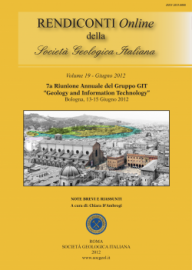
La nuova banca dati geomorfologica della Toscana: implementazione del livello geomorfologico nel Continuum geologico regionale
Filippo Bonciani (*), Tommaso Bigio (*), Andrea Rindinella (*), Altair Pirro (*), Elia Pasqua (*), Maria Giovanna Giagu (*), Anna Marconi (*), Maria Josè Parrilla Chaves (*), Guido Lavorini (**), Francesco Manetti (***) & Massimo Perna (***)
(*) Centro di GeoTecnologie, Università degli Studi di Siena, San Giovanni Valdarno (AR).
(**) Direzione Generale delle Politiche Territoriali e Ambientali. Sistema Informativo Territoriale ed Ambientale, Regione Toscana, Firenze.
(***) Consorzio LaMMA, Sesto Fiorentino (FI).
Volume: 19/2012
Pages: 12-14
Abstract
Tuscany Region Geomorphological Map
The Tuscany Region has recently been provided of a valuable tool for the territorial understanding and planning, consisting of 1:10.000 scale geological database in physical continuity extended to the whole region. The Territorial Geological Survey of Tuscany Region Continuum (TGSTRC) structure expects the additional geothematic data implementation that makes this great tool an useful archive for collecting geographical information aimed to the territorial planning. In the 2011, the research leaded by the Centre for GeoTechnologies of Siena University (CGT) and by the Consortium for Monitoring and Environmental Modelling for Sustainable Development (LaMMA) has improved the TGSTRC development and management through the implementation of geomorphological data derived from all nowadays available sources as the Arno and Serchio rivers Basin Authority database as well as the surveys for the realization of the 1:10.000 scale Geological Map of Tuscany and IFFI, AVI; SCAI, SPEED, CARG projects and the data from the geomorphological maps of the Municipal Structure Plans (MSP), whether available. It has been needed a study for integration and interpretation of the different data sources, aimed to comprehension and adjustment of the elements according to the Regional Geomorphological Legend. The Legend structure satisfies territorial planning needs with particular attention to the requirements of regional laws about the territorial government, without neglecting the morphogenetical, morphoevolutional and the chronomorphological aspects that traditionally constitute the ultimate goal of the geomorphological mapping.
The activity result is a new geomorphological database which provides new features for consistency, detail and extension, and it would constitute a useful tool for the slope gravitational phenomena susceptibility analysis for the whole region.
The new Geomorphological Map shows the geological substrate information, reported on TGSTRC, classified in Lithological Units in order to give full representation of the heterogeneous composition of the rocks outcropping in the region and divided these in classes according to different lithotechnic properties and different associated morphologies. Landslides are represented with complete information on the morphologies associated with them (crown, main scarp and displaced material), as well as with information of the type of movement, activity and the main direction towards the movement has developed or is evolving. For each landslide surveyed the database also lists the information for comparison with the PSC, the source element and a unique identification code that connects the body of the landslide area and its crown. In this way are counted 23.722 active landslides, 80.160 dormant landslides, 4.097 stabilized landslides and 5.439 landslides with not determined activity. The small dimension landslides, mapped as punctual phenomena, are 5.715, while 2.058 areas are registered with general mass movement and 2.794 areas with solifluction phenomena. These data cover the forms and processes related to the known slope instability phenomena. Other information was obtained through specific morphometric analysis on the Digital Elevation Model (DEM) and structural data of arrangement of the surface layering/schistosity reported on TGSTRC. It has been produced a model of computation that give information of slope structure based on mutual orientation of layering/schistosity and the slope itself.
The final product allows to perform analysis on landslide factors from a dataset of great detail and spatial extent which shows a series of extremely varied predisposing conditions and morphologies.
Keywords
Get Full Text